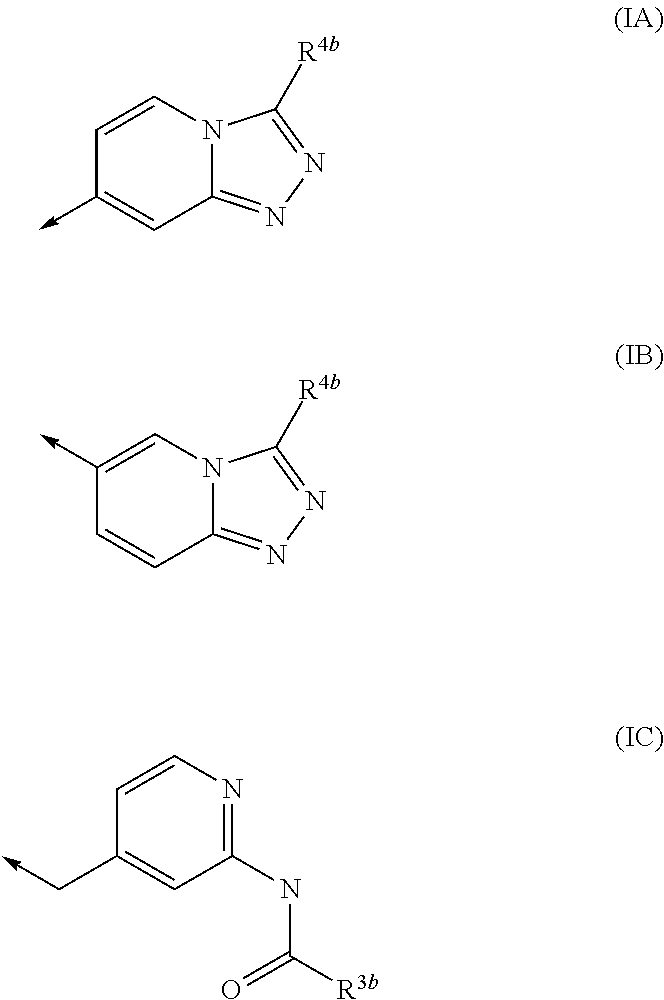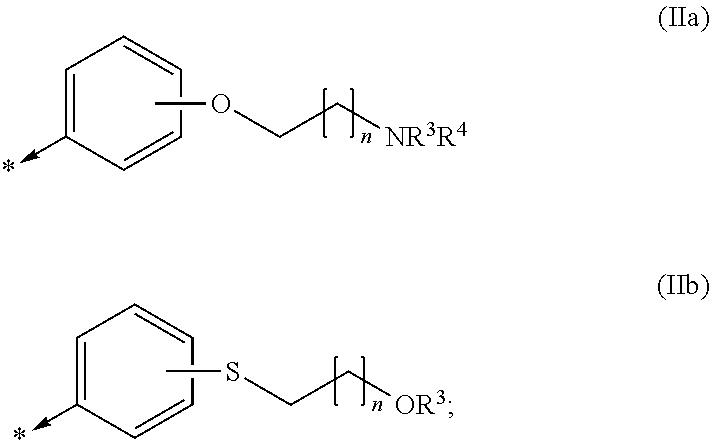Kinase inhibitors
a kinase inhibitor and inhibitor technology, applied in the field of kinase inhibitors, can solve the problems of tnf can be lethal, inflammation in the lung environment, cachexia and anorexia, etc., and achieve the effect of inhibiting cytokine and chemokine production
- Summary
- Abstract
- Description
- Claims
- Application Information
AI Technical Summary
Benefits of technology
Problems solved by technology
Method used
Image
Examples
example 1
1-(5-tert-Butyl-2-phenyl-2H-pyrazol-3-yl)-3-[(1S,4R)-4-(3-isopropyl-[1,2,4]triazolo[4,3-a]pyridin-6-yloxy)-1,2,3,4-tetrahydro-naphthalen-1-yl]-urea
[0154]
a. 2,2,2-Trifluoro-N—(S)-1,2,3,4-tetrahydro-naphthalen-1-yl-acetamide (Intermediate 1a)
[0155]
[0156]Ethyl trifluoroacetate (24.2 mL, 204 mmol) was added dropwise to a stirred solution of (S)-(1,2,3,4-tetrahydro-naphthalen-1-yl)amine (Alfa Aesar) (25.0 g, 170 mmol) and triethylamine (35.5 mL, 255 mmol) in methanol (250 mL) and the reaction stirred for 18 h. The mixture was concentrated to approximately 1 / 3 of its volume and then partitioned between DCM (200 mL) and water (200 mL). The aqueous layer was extracted into DCM (3×) and the combined organic layers were washed with brine, dried (MgSO4) and concentrated in vacuo to yield the title compound (41.1 g, 169 mmol, 99%). 1H NMR (400 MHz, CDCl3): 1.80-1.95 (3H, m), 2.05-2.15 (1H, m), 2.75-2.90 (2H, m), 5.18-5.25 (1H, q, J 5.0 Hz), 6.38-6.48 (1H, br s), 7.12-7.16 (1H, m), 7.20-7.26 (3H...
example 2
1-Cyclopropyl-3-[(1S,4S)-4-(3-isopropyl-[1,2,4]triazolo[4,3-a]pyridin-6-yloxy)-1,2,3,4-tetrahydro-naphthalen-1-yl]-urea
[0171]
a. 2,2,2-Trifluoro-N-((1S,4S)-4-hydroxy-1,2,3,4-tetrahydro-naphthalen-1-yl)-acetamide (Intermediate 2a)
[0172]
[0173]Argon was bubbled through a solution of Intermediate 1b (8.00 g, 31.1 mmol) and [N-[(1S,2S)-2-(amino-κN)-1,2-diphenylethyl]-4-methylbenzenesulfonamidato-κN]chloro[(1,2,3,4,5,6-η)-1-methyl-4-(1-methylethyl)benzene]-ruthenium (Strem Chemicals Inc.; 0.06 g, 0.93 mmol) in dry DMF (100 mL) for 10 min. A premixed combination of formic acid (2.4 mL, 62.2 mmol) and Et3N (8.60 mL, 62.2 mmol) was added and the mixture stirred at 50° C. for 24 h. The mixture was cooled to room temperature and concentrated to ˜25 mL. Water (70 mL) was added and the resulting precipitate filtered, and washed with DCM (3×30 mL) and diethyl ether (30 mL) to leave a solid (4.75 g). The filtrate was decanted to leave a dark solid. Subsequent purification by FCC using 0-30% EtOAc i...
example 3
[0194]The title compound was prepared using Intermediate 3g and (5-tert-Butyl-2-p-tolyl-2H-pyrazol-3-yl)-carbamic acid 2,2,2-trichloro-ethyl ester (Synthetic Communications, 39(22), 3999-4009; 2009) by using an analogous procedure to that described in Example 1 step h. LCMS (Method 5): Rt 4.94 min, m / z 580 [MH+]. 1H NMR (300 MHz, CDCl3): 1.30 (9H, s), 1.43 (6H, dd, J 10.3, 6.9 Hz), 2.12-2.22 (1H, m), 2.36 (3H, s), 2.63-2.71 (1H, m), 3.17-3.26 (1H, m), 4.61-4.65 (1H, m), 5.15 (1H, d, J 8.2 Hz), 5.43-5.51 (1H, m), 6.22 (1H, s), 6.31 (1H, s), 6.99 (1H, d, J 6.9 Hz), 7.09 (1H, d, J 7.1 Hz), 7.15-7.27 (5H, m), 7.33-7.37 (2H, m), 5.57-7.61 (1H, m), 7.75 (1H, m).
PUM
| Property | Measurement | Unit |
|---|---|---|
| mass median aerodynamic diameter | aaaaa | aaaaa |
| dual frequency probe | aaaaa | aaaaa |
| dual frequency probe | aaaaa | aaaaa |
Abstract
Description
Claims
Application Information
 Login to View More
Login to View More - R&D
- Intellectual Property
- Life Sciences
- Materials
- Tech Scout
- Unparalleled Data Quality
- Higher Quality Content
- 60% Fewer Hallucinations
Browse by: Latest US Patents, China's latest patents, Technical Efficacy Thesaurus, Application Domain, Technology Topic, Popular Technical Reports.
© 2025 PatSnap. All rights reserved.Legal|Privacy policy|Modern Slavery Act Transparency Statement|Sitemap|About US| Contact US: help@patsnap.com



